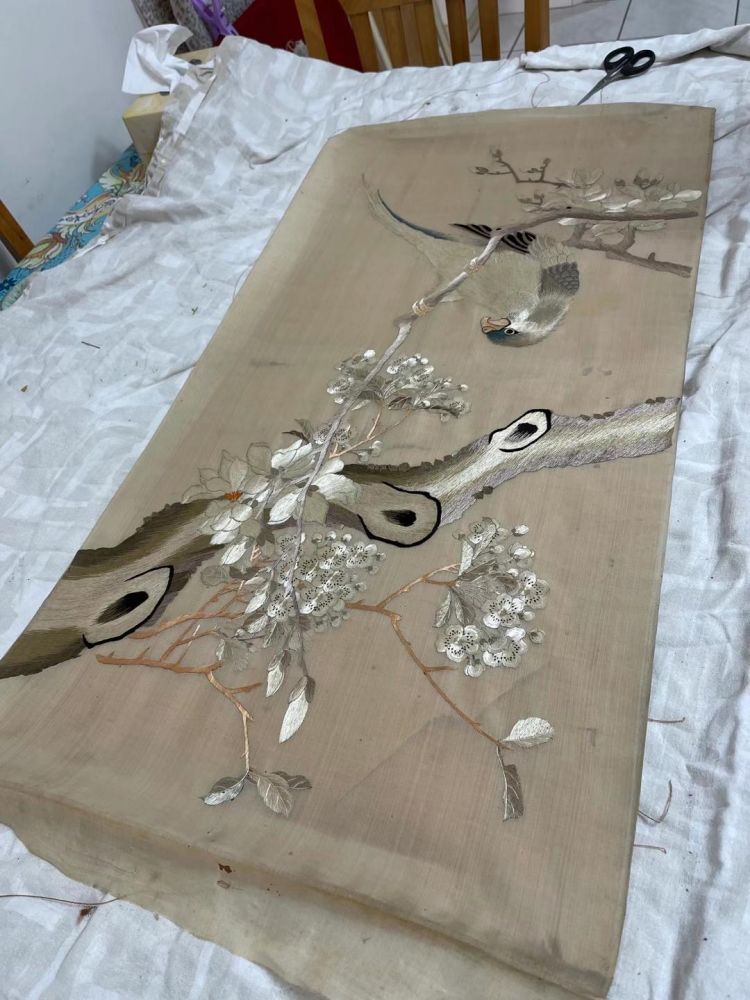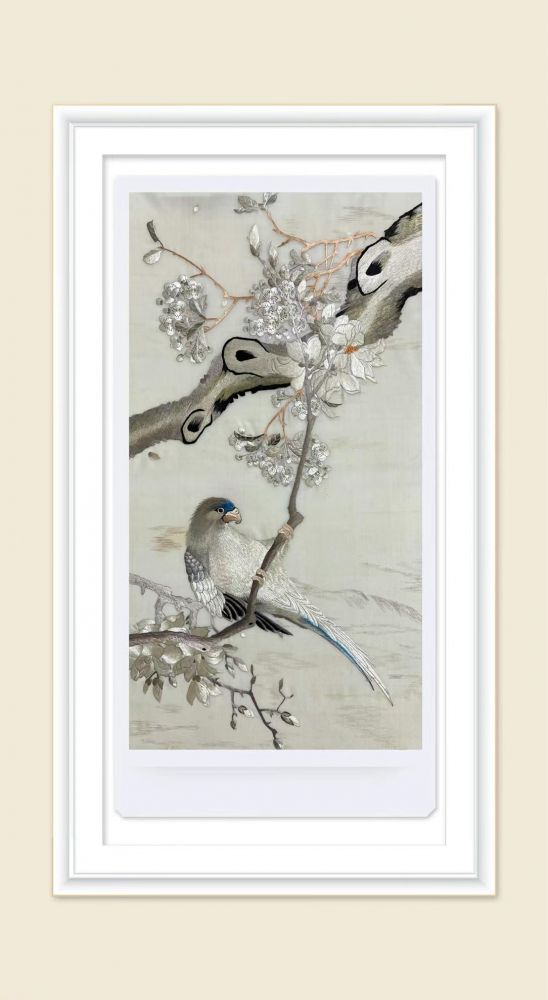鬼穀雄風
有所思,有所感,從曆史的時空中來,再回到曆史的時空中去。一幅顧繡繡品的來曆
這幅鳥兒與梅花的繡品,是有百年曆史的顧繡繡品。是Joe Wilkie(魏超,譯名)家族祖傳。
1、魏超家族溯源
魏超的曾外祖父是華人,名叫William Kong Bow(光寶,譯音,其確切的中文名字可能是Ah Bow Heng[洪亞寶,譯音])。1850年大約12歲時作為契約勞工來到澳大利亞,在新南威爾士西南部的沃加沃加(Wagga Wagga)及岡德蓋(Gundagai)一帶牧場做工。1860年前,他去到蘭濱坪(Lambing Flat,後來改叫揚埠[Young]),在這裏認識了姓Byrnes的一戶愛爾蘭移民家庭。1860年,22歲的光寶就在這裏跟該家庭時年15歲的長女Margaret Byrnes結婚。婚後,Margaret生育了20個孩子,但隻存活6個。1874年,他們的女兒Lucy出生。1888年之前,一位原名Law Goon Ghair(羅君者)來澳洲淘金的廣東小夥子來到揚埠,認識了光寶和Margaret一家,把名字的英文改成了William Gon Chee(注釋1)。當光寶和Margaret在1888年至1889年間決定全家向北遷移,以尋找更好的生活時,羅君者已經心儀其女兒Lucy,決定一起走。他們最終在1889年來到昆士蘭的南達令丘陵區(Southern Darling Downs)南端與新南威爾士交界的基拉尼鎮(Killarney)定居下來,購地經營農場。一年後,光寶因喉癌去世,由Margaret帶領六個孩子繼續經營。羅君者則在這裏做木匠。1894年,20歲的Lucy與26歲的羅君者結婚。他們夫婦隨之也挨著Lucy父母的農場買下一片土地,同樣是經營農場,種植小麥、煙葉、玉米、蔬菜,也有一些牧業。他們共生育了12個孩子(9子3女),全部存活。最小的是女兒,生於1917年,名叫Doris Gon Chee,她就是魏超的母親。
2、顧繡繡品來曆
1916年,羅君者19歲的二子Cecil Gon Chee去到廣東探親,次年5月返澳。那幅鳥兒與梅花的顧繡繡品,就是這個時候由Cecil從中國帶回來澳洲,交給兩個大妹妹保存。
3、顧繡簡介
中國刺繡源遠流長,至明清時期形成了蘇繡、湘繡、粵繡和蜀繡四大名繡,但脫離生活實用成為獨立欣賞工藝的則是顧繡。江蘇鬆江顧名世家發揚宋元繡畫技法,以宋元山水花鳥人物書畫作品為底稿,運用各種絲線材料入繡畫,精妙天成,針法細膩多變,繡工善美;畫麵繡繪結合,以繡代畫,是其最為獨特之處;同時,吸收西方浪漫主義突顯透視的效果,自成風格,是為顧繡,得以聞名傳世。其風格和針法對四大名繡尤其是蘇繡有較大影響。但顧繡產品到清末式微,民國初年鬆江府開設鬆筠女子職校顧繡班,旨在振興。Cecil去廣東祖家的時間,正好與顧繡的振興時期相吻合。
4、繡品修複
1952年,Doris在布裏斯本嫁給德國裔的Alexander Wilkie,生育一女二子,魏超排行老二。Doris在1962年去世,魏超姐弟受到兩個姨媽的大力照顧,並將那幅繡品轉交給他保存。因其對該繡品不了解,保管不得法,以致繡麵發黃,破損嚴重。2022年9月,他將其送給位於布裏斯本的繡珍閣主人——刺繡大家高青敏,由其處理。高青敏覺得繡品很具繡功,表現力強,清新淡雅,顯現的是宋元山水花鳥畫的特點,遂花費了約一個月的時間將其破損及發黴之處一一補針加以修複。這幅繡品,繡麵是鳥兒與梅花,確實是一幅顧繡繡品。
5、展示與意義
高青敏將這幅繡品修複,使其煥然一新。Joe Wilkie認為,是高青敏的精湛技藝使得這幅繡品重生,應由這位刺繡大家決定其最終歸宿;高青敏則認為,沒有Joe Wilkie將此具有重要曆史價值的繡品拿出來,我們就無法看到這樣的精美繡品,她應該屬於大家。由此可見,這幅顧繡繡品在展現中澳商品的交流及澳華曆史的延續傳承與融合上,具有重要的價值和曆史意義。
The History of A Gu Embroidery Piece
This bird and plum blossom embroidery is an over hundred years old Gu embroidery piece that has been passed down in the Joe Wilkie family.
1. Tracing the Lineage of the Joe Wilkie Family
Joe wilkie's great-grandfather was a Chinese man named William Kong Bow (his exact Chinese name may be Ah Bow Heng). Around 1850, at about 12 years old, he arrived in Australia as an indentured laborer and worked in the Wagga Wagga and Gundagai areas of southwestern New South Wales. Before 1860, he moved to Lambing Flat (later renamed Young), where he met an Irish immigrant family named Byrnes. In 1860, at the age of 22, Kong Bow married Margaret Byrnes, the 15-year-old eldest daughter of the Byrnes family.
After marriage,Margaret gave birth to 20 children, but only six survived. Their daughter Lucy was born in 1874. Before 1888, a young man from Guangdong named Law Goon Ghair came to Australia to seek his fortune in gold mining. He met Kong Bow and Margaret's family in Young and anglicized his name to William Gon Chee. When Kong Bow family decided to move northward between 1888 and 1889 in search of a better life, Law Goon Ghair had already set his sights on their daughter Lucy and decided to join them. They eventually settled in Killarney, at the southern end of the Southern Darling Downs in Queensland, near the border with New South Wales, in 1889, where they purchased land and operated a farm.
A year later,Kong Bow passed away from throat cancer, leaving Margaret to lead the family farm with their six children. Law Goon Ghair worked as a carpenter in Killarney. In 1894, 20-year-old Lucy married 26-year-old Law Goon Ghair. The couple bought land adjacent to Lucy's parents' farm and also operated a farm, growing wheat, tobacco, corn, vegetables, and engaging in some livestock farming. They had a total of 12 children (9 sons and 3 daughters), all of whom survived. The youngest, a daughter born in 1917, was named Doris Gon Chee, who is Joe Wilkie's mother.
2. Origin of the Gu Embroidery Piece
In 1916, Cecil Gon Chee, the second son of Law Goon Ghair, was 19 years old when he went to Guangdong to visit relatives. He returned to Australia in May of the following year. It was during this time that Cecil brought back the Gu embroidery piece depicting birds and plum blossoms from China to Australia and entrusted it to his two older sisters for safekeeping.
3. Introduction to Gu Embroidery
Chinese embroidery has a long history, and during the Ming and Qing dynasties, four major styles of embroidery emerged: Su embroidery, Xiang embroidery, Yue embroidery, and Shu embroidery. However, Gu embroidery stands out as an independent craft for appreciation, detached from practical use.
The Gu family in Songjiang, Jiangsu province, inherited and developed the embroidery techniques of the Song and Yuan dynasties, using landscape, flowers, birds, figures, and calligraphy works from the Song and Yuan dynasties as templates. They utilized various silk threads to embroider these paintings, creating exquisite and ingenious works with delicate and varied stitching techniques. The combination of embroidery and painting, with embroidery replacing traditional painting, is the most unique feature of Gu embroidery. Simultaneously, it absorbed the perspective effects highlighted by Western romanticism, forming its own style, which became renowned as Gu embroidery. Its style and stitching techniques have had a significant influence on the four major styles of embroidery, especially Su embroidery.
However, Gu embroidery declined by the end of the Qing dynasty. In the early years of the Republic of China, the Songjiang Prefecture established the Gu Embroidery Class at the Songyun Women's Vocational School with the aim of revitalizing this art form. Cecil's visit to his ancestral home in Guangdong coincided with the period of revitalization of Gu embroidery.
4. Embroidery Restoration
In 1952, Doris married Alexander Wilkie, of German descent, in Brisbane, and they had one daughter and two sons, with Joe Wilkie being the second eldest. Doris passed away in 1962, and Joe and his siblings were cared for by their two aunts, who entrusted him with the preservation of a piece of embroidery. Due to his lack of understanding of the embroidery, he was unable to properly care for it, resulting in yellowing and severe damage to the embroidered surface.
In September 2022, Joe Wilkie entrusted the embroidery to the embroidery expert Jenny Gao for restoration. Jenny Gao recognized the exquisite craftsmanship of the embroidery, its strong expressive power, and its fresh and elegant style, reflecting the characteristics of Song and Yuan dynasty landscape, flowers, and bird paintings. He spent approximately a month repairing the damaged and moldy areas, meticulously restoring each one with needlework. This piece of embroidery, depicting birds and plum blossoms, is indeed a Gu embroidery masterpiece.
5. Exhibition and Significance
Jenny Gao's restoration work on this embroidery has revitalized it. Joe Wilkie believes that it is Jenny's superb craftsmanship that has brought this embroidery back to life, and therefore, it should be up to this embroidery expert to decide its final destination. However, Jenny Gao believes that without Joe bringing out this embroidery, which holds significant historical value, we wouldn't have been able to appreciate such exquisite craftsmanship, and therefore, it should belong to everyone.
From this, it can be seen that this Gu embroidery piece holds significant historical value and significance in showcasing the exchange of goods between China and Australia, as well as the continuation, inheritance, and integration of Australian Chinese history.
 2022年10月,繡品送來時的破損情況。
2022年10月,繡品送來時的破損情況。
 2022年12月,修複後的顧繡繡品。
2022年12月,修複後的顧繡繡品。
 2023年5月,在繡珍閣繡品展覽開幕式上,高青敏和魏超(Joe Wilkie)修複後的顧繡繡品合影。
2023年5月,在繡珍閣繡品展覽開幕式上,高青敏和魏超(Joe Wilkie)修複後的顧繡繡品合影。
————————
注釋1:羅君者的這個名字,來源於《僑選中央民意代表飛枝區及布利士彬華僑選民登記名冊》,國史館,典藏號:033-020102-0074。




